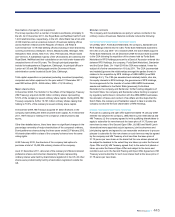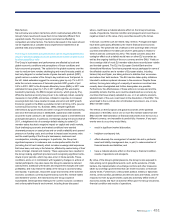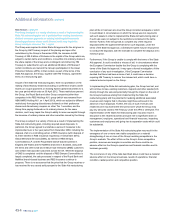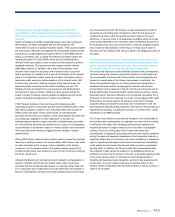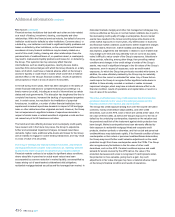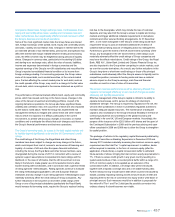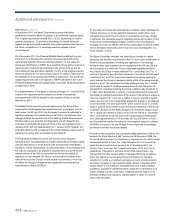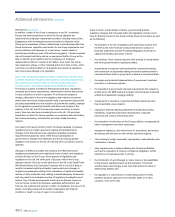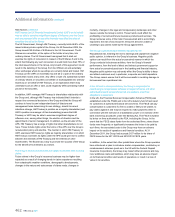RBS 2011 Annual Report Download - page 454
Download and view the complete annual report
Please find page 454 of the 2011 RBS annual report below. You can navigate through the pages in the report by either clicking on the pages listed below, or by using the keyword search tool below to find specific information within the annual report.
452 RBS Group 2011
Risk factors continued
The Group’s ability to meet its obligations including its funding
commitments depends on the Group’s ability to access sources of
liquidity and funding
Liquidity risk is the risk that a bank will be unable to meet its obligations,
including funding commitments, as they fall due. This risk is inherent in
banking operations and can be heightened by a number of factors,
including an over reliance on a particular source of wholesale funding
(including, for example, short-term and overnight funding), changes in
credit ratings or market-wide phenomena such as market dislocation and
major disasters. Credit markets worldwide have experienced severe
reductions in liquidity and term-funding during prolonged periods in recent
years. In particular, funding in the interbank markets, a traditional source
of unsecured short-term funding, has been severely disrupted. Although
credit markets generally improved during the first half of 2011, wholesale
funding markets have continued to suffer, particularly for European banks
as the sovereign debt crisis worsened during the second half of 2011. As
aresult, a number of banks were reliant on central banks as their
principal source of liquidity and central banks increased their support
provisions to banks with the European Central Bank providing significant
liquidity in the last few months of 2011 (including long-term refinancing
operations facilities (offering loans with a term of up to three years) and
broader access to US dollar funding). Although these efforts appear to be
having a positive impact, global credit markets remain disrupted. The
market perception of bank credit risk has changed significantly recently
and banks that are deemed by the market to be riskier have had to issue
debt at a premium to the equivalent cost of debt for other banks that are
perceived by the market as being less risky. Any uncertainty regarding
the perception of credit risk across financial institutions may lead to
further reductions in levels of interbank lending and associated term
maturities and may restrict the Group’s access to traditional sources of
liquidity.
The Group’s liquidity management focuses, among other things, on
maintaining a diverse and appropriate funding strategy for its assets in
line with the Group’s wider strategic plan. At certain times during periods
of liquidity stress, the Group has been required to rely on shorter-term
and overnight funding with a consequent reduction in overall liquidity, and
to increase its recourse to liquidity schemes provided by central banks.
Such schemes require the pledging of assets as collateral, the eligibility
and valuation of which is determined by the applicable central bank.
Changes to these valuations or eligibility criteria can negatively impact
the available assets and reduce available liquidity access particularly
during periods of stress when such lines may be needed most. Further
tightening of credit markets could have a materially adverse impact on
the Group. There is also a risk that corporate and financial institution
counterparties may seek to reduce their credit exposures to banks and
other financial institutions, which may cause funding from these sources
to no longer be available. There is also likely to be increased competition
for funding due to the significant levels of refinancing expected to be
required by financial institutions during 2012, which may also reduce the
level of funding available from these sources. Under such circumstances,
the Group may need to seek funds from alternative sources potentially at
higher costs than has previously been the case or may be required to
consider disposals of other assets not previously identified for disposal to
reduce its funding commitments.
In the context of its liquidity management efforts, the Group has sought to
increase the average maturity of its wholesale funding, which has had the
effect of increasing the Group’s overall cost of funding. In addition, the
Group expects to proportionately increase its reliance on longer-term
secured funding, such as covered bonds.
Like many banking groups, the Group relies increasingly on customer
deposits to meet a considerable portion of its funding and it is actively
seeking to increase the proportion of its funding represented by customer
deposits. However, such deposits are subject to fluctuation due to certain
factors outside the Group’s control, such as a loss of confidence,
increasing competitive pressures for retail customer deposits or the
encouraged or mandated repatriation of deposits by foreign wholesale or
central bank depositors, which could result in a significant outflow of
deposits within a short period of time. There is currently heavy
competition among UK banks for retail customer deposits, which has
increased the cost of procuring new deposits and impacted the Group’s
ability to grow its deposit base and such competition is expected to
continue. An inability to grow, or any material decrease in, the Group’s
deposits could, particularly if accompanied by one of the other factors
described above, have a materially adverse impact on the Group’s ability
to satisfy its liquidity needs.
The occurrence of any of the risks described above could have a material
adverse impact on the Group’s financial conditions and results of
operations and/or result in a loss of value in its securities.
The Independent Commission on Banking has published its final report
on competition and possible structural reforms in the UK banking industry.
The UK Government has indicated that it supports and intends to
implement the recommendations substantially as proposed, which could
have a material adverse effect on the Group
The Independent Commission on Banking (ICB) was appointed by the
UK Government in June 2010 to review possible structural measures to
reform the UK banking system in order to promote, amongst other things,
stability and competition. The ICB published its final report to the Cabinet
Committee on Banking Reform on 12 September 2011, which set out the
ICB’s views on possible reforms to improve stability and competition in
UK banking. The final report made a number of recommendations,
including in relation to (i) the implementation of a ring-fence of retail
banking operations, (ii) increased loss absorbency (including bail-in i.e.
the ability to write-down debt or convert it into an issuer’s ordinary shares
in certain circumstances) and (iii) promotion of competition. On 19
December 2011 the UK Government published its response to the final
report and indicated its support and intention to implement the
recommendations set out in the final report substantially as proposed.
The UK Government indicated that it will work towards putting in place
the necessary legislation by May 2015, requiring compliance as soon as
practicable thereafter and a final deadline for full implementation of 2019.
The Group will continue to participate in the debate and to consult with
the UK Government on the implementation of the recommendations set
out in the final report and in the UK Government’s response, the effects
of which could have a material adverse effect on the Group’s structure,
results of operations, financial condition and prospects.
Additional information continued





